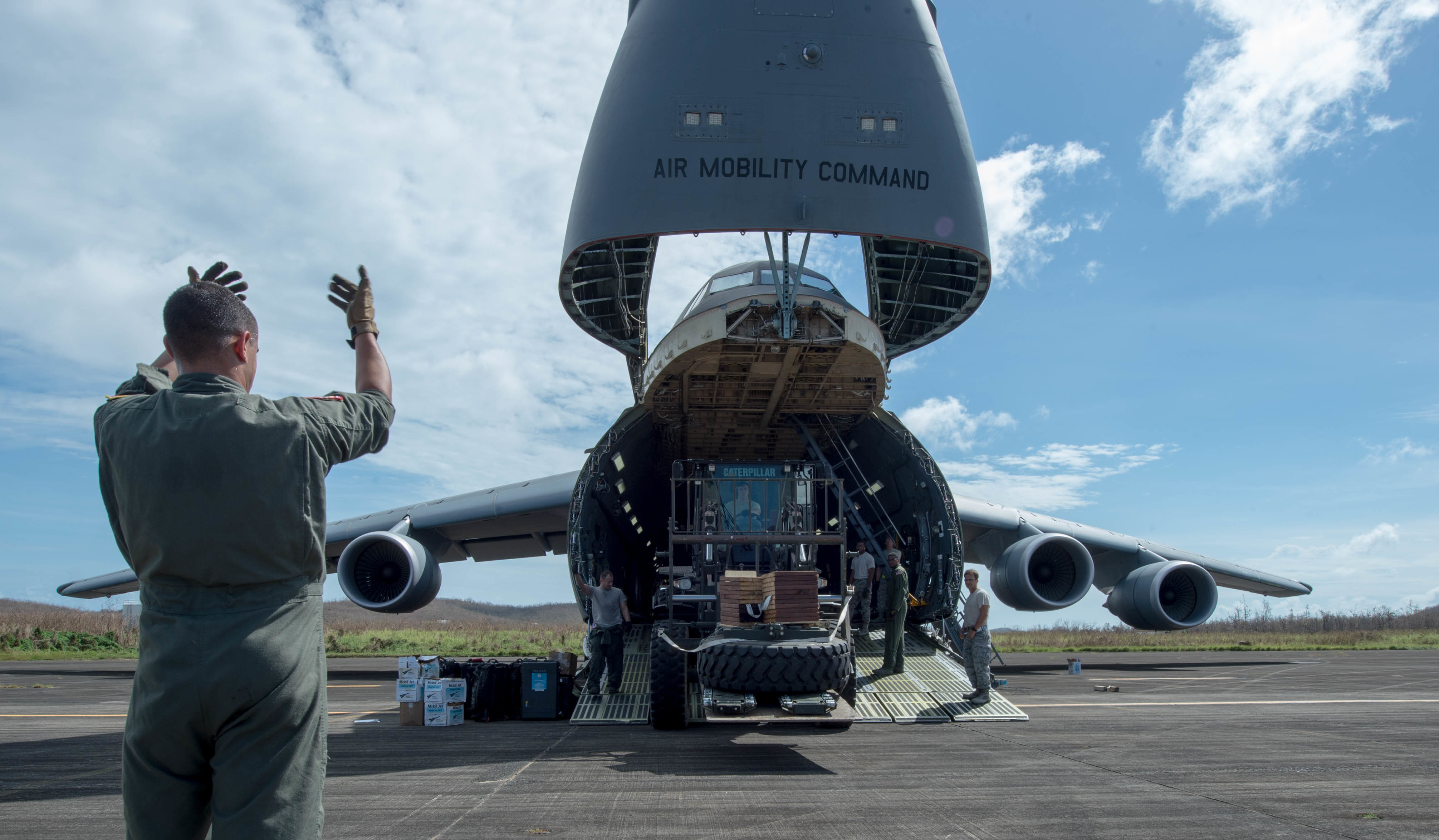The 821st Contingency Response Group offloads equipment from a C-5M Super Galaxy deployed from Travis AFB, Calif., at Roosevelt Roads, Puerto Rico, Sept. 25, 2017. Air Force photo by SSgt. Robert Hicks.
The Air Force’s mobility crews faced a “confluence of events” for about four months in 2017 that the command hasn’t faced in decades.
Hurricanes in both the continental United States and the Caribbean, along with wildfires across the west and an earthquake in Mexico, all in addition to ongoing wartime and training needs.
During this span, the command flew more than 3,000 humanitarian assistance disaster relief missions and throughout 2017 the air operations center was tasked with organizing about 600 sorties per day.
“We were busy, and we still had combat operations going on in the CENTCOM area of responsibility, and also trying to get after full spectrum readiness in case we have to go to somewhere else on the globe if the nation needs us to go do that,” said Maj. Gen. Thomas Sharpy, the deputy commander of Air Mobility Command.
The pace was so high, that general officers even got short notice taskings. Sharpy flew to Puerto Rico for the storm response with three hours notice, where he spent three weeks as the joint forces land? component deputy commander. Forty-eight states ended up providing National Guard support to the storm response.
During this effort, AMC contingency response airmen opened up San Juan International Airport and three more airfields to bring in critical supplies. This involved clearing damage and setting up electricity for navigation aids, communication, and lights, along with setting up the cargo ramp to get critical aid to begin flowing in to the area.
US forces used helicopters and MV-22 Ospreys to get this aid to remote areas, sometimes right when they were needed the most. Sharpy recounted one mission, where he flew on an Osprey to a community and met a family that ran out of food the day before. When they arrived, a woman asked him to take a picture with her young daughter, so this delivery could have saved their lives.
“It was awesome to see the results of everything we train for, everything that we worked so hard to do, and to get to see it in execution,” Sharpy said. “To get someone to tell me that you might have saved their daughter’s life, it put it all together for me and made it worth all the time and effort that we put into it, whether it’s in training, or in that instance executing the mission. We provide hope.”
In the wake of this storm response, one of the biggest lessons learned for both military and civilian airfields has been to be ready for the second step of bringing in aid because disaster relief is unpredictable.
“If you have any type of this that could happen in your airfield, then you need to practice and you need a plan and you need to work with the contingency response forces to exercise those things,” he said. “Because if it can happen, it’s just a matter of time and it will happen.”
This was an issue contingency response forces faced in response to the 2010 earthquake in Haiti. Aircraft came in to offload supplies, but there wasn’t any way to quickly offload the supplies and move aircraft out, so incoming aid had to be turned away.
The AMC contingency response forces that opened these airfields are also the ones tasked with setting up remote airstrips as part of the ongoing fight against ISIS in Iraq and Syria, in Afghanistan, and in other locations across the globe. Following the disaster response and the slowed pace of anti-ISIS operations, these forces finally had a chance to “reset” and get back to standing by for the next mission.
“For the first time in a long time our contingency response forces are ready and pulling the alert duties” in case they are “called upon to be responsive across the globe,” Sharpy said.
For the broader AMC fleet, operations have remained high in the Middle East but the tactics have stayed “relatively consistent.” The Air Force has focused so much on the Middle East, that it took risk in other areas of the globe. Now, mobility aircraft and aircrews are training and preparing for other areas that they have not been able to focus on. For example, operating in a denied environment or facing chemical and biological threats that could be faced in a higher-end fight.
“We’re just trying to make sure that we are ready, if called upon, to project that airpower in support of the joint forces across the combatant commands across the spectrum of conflict,” Sharpy said. “We’re really good at CENTCOM, but there’s other places in the world that we have to be ready to fight in, and with the tempo we have, we’ve had to go back and provide readiness space to be able to get after some of those high-end fights in case we are called upon to do that.
